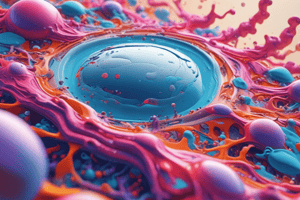Podcast
Questions and Answers
Which of the following is NOT a function of the kidneys?
Which of the following is NOT a function of the kidneys?
- Regulating salt balance
- Regulating pH balance of blood
- Regulating water balance
- Regulating CO2 levels in the blood (correct)
What is the net effect of H+ secretion into kidney tubules on blood pH?
What is the net effect of H+ secretion into kidney tubules on blood pH?
- Increase in blood pH
- Indirect effect on HCO3- levels
- Decrease in blood pH (correct)
- No effect on blood pH
What is the major buffer present in the blood for pH regulation?
What is the major buffer present in the blood for pH regulation?
- H2O
- HCO3- (bicarbonate) (correct)
- K+ ions
- NaCl
Which enzyme catalyzes both intra- and extracellular production of carbonic acid?
Which enzyme catalyzes both intra- and extracellular production of carbonic acid?
When arterial pressure is less than 85 mm Hg, which of the following is NOT expected to occur?
When arterial pressure is less than 85 mm Hg, which of the following is NOT expected to occur?
In cardiac muscle, the rapid depolarization phase of an action potential is primarily due to:
In cardiac muscle, the rapid depolarization phase of an action potential is primarily due to:
Which of the following best describes the refractory period in cardiac muscle cells?
Which of the following best describes the refractory period in cardiac muscle cells?
Which statement accurately describes a characteristic of cardiac muscle?
Which statement accurately describes a characteristic of cardiac muscle?
What is the primary function of the atrioventricular (AV) node in the heart's electrical conduction system?
What is the primary function of the atrioventricular (AV) node in the heart's electrical conduction system?
What is the purpose of countercurrent exchange in biological systems?
What is the purpose of countercurrent exchange in biological systems?
How do electrochemical gradients serve as sources of potential energy in transport mechanisms?
How do electrochemical gradients serve as sources of potential energy in transport mechanisms?
In the context of plant biology, what is the significance of 'genetic redundancy'?
In the context of plant biology, what is the significance of 'genetic redundancy'?
How does the action spectrum differ from the absorption spectrum in photosynthesis?
How does the action spectrum differ from the absorption spectrum in photosynthesis?
What is the primary function of photophosphorylation in chloroplasts during photosynthesis?
What is the primary function of photophosphorylation in chloroplasts during photosynthesis?
What is the role of phytochrome in plants?
What is the role of phytochrome in plants?
What recurring mechanism involves hormone action at many different levels and the concept of signaling webs?
What recurring mechanism involves hormone action at many different levels and the concept of signaling webs?
How do C4 and CAM plants differ in their carbon fixation pathways?
How do C4 and CAM plants differ in their carbon fixation pathways?
Which plant photoreceptor plays a crucial role in regulating growth by sensing light wavelengths?
Which plant photoreceptor plays a crucial role in regulating growth by sensing light wavelengths?
What is the primary function of bioassays when detecting an unknown chemical in plants?
What is the primary function of bioassays when detecting an unknown chemical in plants?




